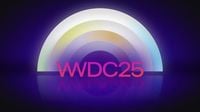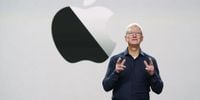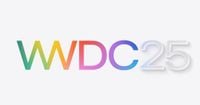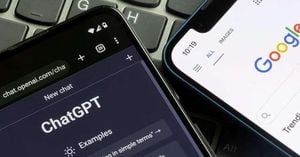Apple’s Worldwide Developers Conference (WWDC) 2025 kicked off on June 9 at 1 p.m. Eastern Time, marking one of the tech giant’s most anticipated annual events outside of its September iPhone launch. Held at Apple Park’s iconic "spaceship" campus in Cupertino, California, the conference gathered developers, students, and press to witness a slew of software updates and unveilings across Apple’s ecosystem.
CEO Tim Cook opened the keynote with a pre-recorded presentation that set the tone for what many hoped would be a pivotal moment for Apple’s software and artificial intelligence (AI) ambitions. The event was streamed live on YouTube and Apple’s website, drawing global attention as the company sought to demonstrate its innovation prowess amid growing competition in AI and software design.
Central to WWDC 2025 was the unveiling of Apple’s new design language, dubbed "Liquid Glass." This broad design overhaul spans iPhone, Mac, Apple Watch, Apple Vision Pro, and other devices, bringing a sleek, translucent aesthetic inspired by the Vision Pro headset’s visionOS. The Liquid Glass concept emphasizes floating, see-through controls that adapt dynamically—shrinking when not in use to maximize screen real estate and enhancing user interaction with a fresh, modern feel.
Apple’s iPhone software, now officially named iOS 26 to align with a new unified naming convention that ties all Apple operating systems to the calendar year, features this Liquid Glass design prominently. The home screen and app icons receive a translucent refresh, and the lock screen introduces dynamic wallpapers and a reimagined "now playing" interface for music. This naming shift extends to watchOS 26, tvOS 26, macOS Tahoe, and VisionOS 26, simplifying version tracking for users and developers alike.
The next macOS iteration, macOS Tahoe, retains its Californian-inspired name while adopting the Liquid Glass design language. Tahoe introduces a transparent menu bar, customizable Control Center and menu bar controls, and the ability to personalize folder colors with emojis and symbols. The update also brings new Apple Intelligence features, including an enhanced Spotlight search that remembers search history and allows running shortcuts via "quick keys." The Shortcuts app itself gains "Intelligent Actions," leveraging AI to create personalized automations that combine multiple app steps, either on-device or through ChatGPT integration.
Continuity between Apple devices received significant enhancements. Mac users can now access traditional iPhone features like phone calls directly on their Mac screens, complete with large contact images for incoming calls. Live Activities, such as Uber Eats delivery updates, can be monitored from the Mac menu bar, with the option to mirror the full iPhone screen for seamless multitasking.
Apple’s VisionOS 26, powering the $3,499 Vision Pro spatial computing headset, received an "expansive update." Users can place widgets throughout their virtual space, which remain anchored thanks to a new Widgets app. The update promises a richer spatial content experience, further integrating the Vision Pro into Apple’s ecosystem.
On the Apple Watch front, watchOS 26 embraces the Liquid Glass aesthetic while introducing new features like Workout Buddy, an AI-powered fitness coach that aggregates workout data and provides motivational encouragement via text-to-speech. The "Smart Stack" feature intelligently surfaces relevant apps based on context, such as prompting a workout when entering a gym. A new "wrist flick" gesture allows users to dismiss notifications, mute calls, silence timers, or close the Smart Stack with a simple flick of the wrist. The Messages app on Apple Watch now supports custom backgrounds and live translations, mirroring iOS 26 enhancements.
Apple’s commitment to AI was a focal point throughout the conference. Craig Federighi, Senior Vice President of Software Engineering, revisited Apple Intelligence, emphasizing privacy and the expansion of language support. He acknowledged that Siri’s anticipated overhaul, hyped at last year’s WWDC, remains delayed, stating, "This work needed more time to reach our high quality bar." Nonetheless, Federighi teased more Apple Intelligence features sprinkled across the announcements, including Visual Intelligence—Apple’s AI-driven visual search tool that now works on iPhone screens. Users can tap on screenshots to search for specific products or events, create calendar entries, or query ChatGPT about on-screen content.
Gaming took a leap forward with the introduction of a new standalone "Games" app, which consolidates Apple Arcade titles, purchased games, and social features like "Challenges" for competing with friends. This app aims to revitalize Apple’s gaming ecosystem, offering a hub that integrates Game Center leaderboards and multiplayer experiences.
Apple Wallet also saw substantial updates. It now supports digital IDs in nine participating U.S. states, allowing users to store their ID for domestic travel at TSA checkpoints and for age or identity verification in apps and in person. The app enhances travel convenience by learning users’ travel habits and providing commute notifications with alternate route suggestions. Wallet also expands car key support to more manufacturers, including Porsche, and adds detailed boarding pass information with airport maps and estimated arrival sharing. Additionally, users can redeem credit card reward points and track orders with intelligent notifications.
Messaging improvements in iOS 26 include the ability to set custom backgrounds for group chats using Apple’s Image Playground, create polls (with AI detection for relevant situations), send and receive Apple Cash, and see typing indicators for individual group members. An "Unknown Senders" feature filters messages from unknown numbers into a separate area, reducing clutter and enhancing user control.
The Phone app was overhauled to unify voicemails, recents, and favorites into a streamlined interface. It introduces AI-powered voicemail summaries for quick skimming, automatic background screening of unknown calls, and a "Hold Assist" feature that detects hold music and keeps users’ place in queues until live assistance is available.
CarPlay Ultra, launched in select vehicles including some Aston Martin models, offers a customizable dashboard with widgets and vehicle controls for radio and climate, designed to keep drivers focused on the road. The Camera app received a minimalist redesign, hiding modes and settings behind intuitive swipes, while the Photos app was optimized for faster media searching.
Apple Music now features live lyric translations and pronunciation guides to enhance karaoke experiences, alongside AutoMix, which seamlessly transitions between songs. Users can pin favorite artists, albums, or songs to the home screen for quick access.
Despite the many software advancements, Apple’s stock experienced a slight dip during the event, falling 0.6% in afternoon trading on June 9, 2025, while major indices like the S&P 500 and Nasdaq traded higher. Analysts noted that while the updates were solid, they might be seen as incremental rather than groundbreaking, particularly regarding AI, where Apple is still perceived as trailing competitors.
Rumors about hardware were tantalizing but mostly unconfirmed. A long-rumored HomePod with a 6- to 7-inch screen, blending smart speaker capabilities with smart home controls and FaceTime video calling, might be teased, though its release remains uncertain. Apple also promoted its upcoming "F1" movie, starring Brad Pitt, set to premiere on June 27, 2025, adding a touch of entertainment flair to the conference.
WWDC 2025 demonstrated Apple’s strategic focus on design cohesion, AI integration, and ecosystem continuity. While some critics remain skeptical about the pace of Apple Intelligence’s progress, the company’s unified software naming, Liquid Glass design overhaul, and expanded AI features across devices signal a clear vision for the next chapter of Apple’s software evolution.






